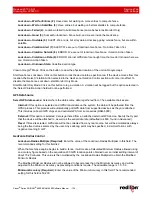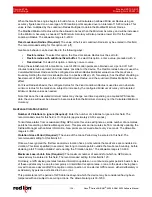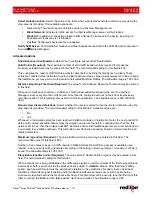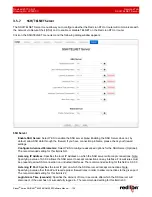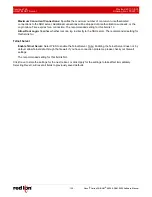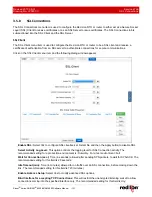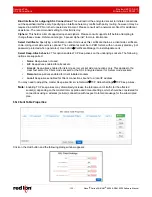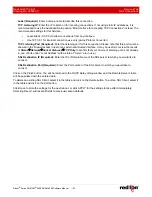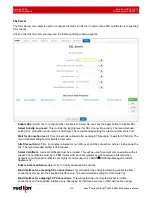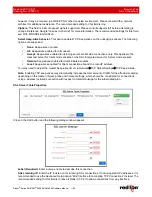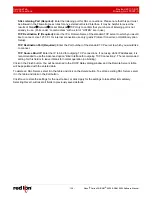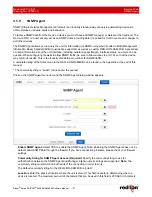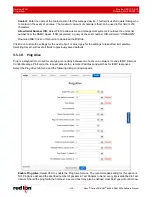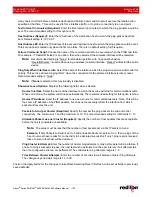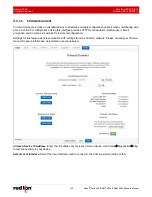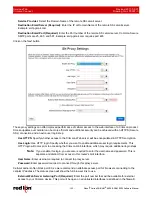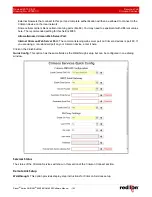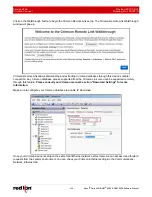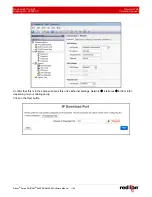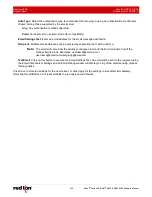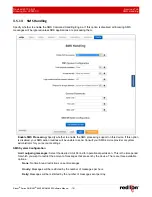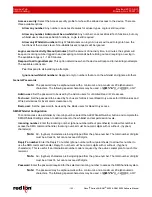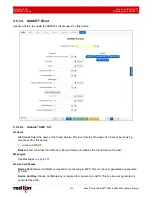
Revised 2017-08-31
Services Tab
Drawing No. LP0997-C
Ping Alive
Sixnet
®
Series SN/RAM
®
6000 & RAM 9000 Software Manual
- 139 -
many hosts must fail before a failure is declared and Failure Command Script will execute the failure action
specified at that time. This can be used to force interface traffic, or to probe connectivity to an end point.
Test Interval (in minutes)(Required):
Enter the time interval (in minutes) to which the ping packets would be
sent. The recommended setting for this option is 50.
Host Address (Required):
Enter the IP Address of the destination host to which the ping packet would be
sent. Default setting is “127.0.0.1”.
Host Address #2:
Enter the IP Address of the second destination host to which the ping packet would be sent.
This second host is tested only when the first one fails. There is no default setting for this option.
Failure Command Script:
Choose the name of the command script to be executed when the PING test fails.
For example, if “Restart Wireless” is an option, then when selected, the wireless interface will be restarted.
Note:
Recommended setting is “
None
” for standard operation with no special behaviors.
“
RestartWireless
” is useful when using a wireless (cellular) interface. “
Reboot
” will restart the entire
device.
Ping Only When Interface is Idle:
Select the name of the interface which the ping alive service will monitor for
activity. This service will send a ping ONLY when the connection for the selected interface is idle or reset.
Recommended setting is “
None
”.
Note:
If
None
is selected, this functionality is disabled.
Show Advanced Options:
Displays the following fields when selected.
Source Interface:
Select the name of the interface to which the service will bind for communications tests.
When set to
None
, the system will choose automatically. The recommended setting for this option is None.
Source IP Address:
Enter the IP address to use as a source for communications tests. Note: This will be
the source IP address of the PING packets, but does not necessarily reflect the interface from which
packet will traverse the unit.
Packets to Send per Cluster (Required):
Specify the number the ping packets to send out to test
connectivity. The minimum is 1 and the maximum is 10. The recommended setting for this field is 5 - 10.
Allowable Packet Loss per Cluster (Required):
Specify the number of lost packets that are acceptable
before the link is considered unavailable.
Note:
The value must be less that the number of test packets set via Test Packets to Send.
Example:
If Test Packets to Send is set to 5 and Allowable Packet Loss is set to 3, then 2 pings of the
5 sent out must have replies for connectivity to be declared successful. If only 1 ping reply is received,
then a failure to that host will be declared.
Ping Cluster to Attempt:
Enter the number of cluster ping attempts to retry before determining a failure. If
one set of pings succeeds to pass, the next test will be performed on the next interval. If all attempts fail,
then the configured action(s) are performed. The valid cluster ping attempts range is 1 -5.
Time Between Cluster Attempts:
Enter the number of seconds to wait between Cluster Ping Attempts.
The valid grace period wait range is 15 - 300.
Click on the
Apply
button for the changes to take effect. Selecting Revert / Refresh, will reset all fields to previously
saved defaults.

